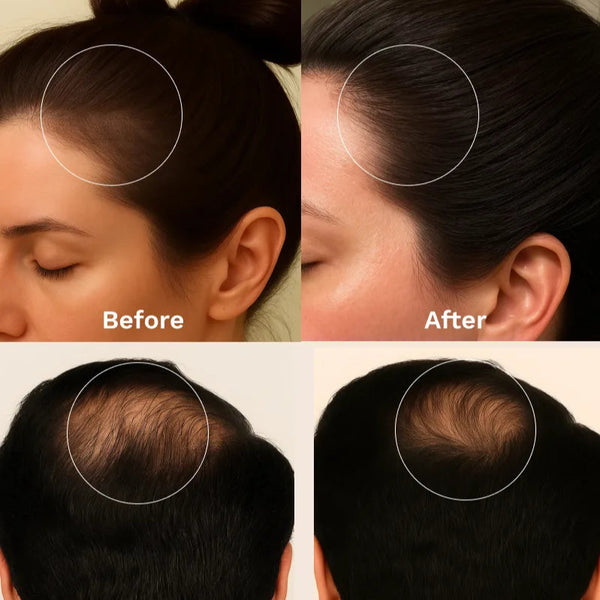In this article
If hair loss runs in your family, you probably want straight answers. Does genetics cause hair loss? Which genes matter? Is it inherited from your mom’s side?
Discover how genetics shapes hair loss and hair growth, which genes are involved, how inheritance really works, what genetic tests can and cannot tell you, and how to use that knowledge to plan your care.
Key takeaways
-
Genetics play a major role in pattern hair loss, especially in men, but there is no single “baldness gene.” AR on the X chromosome is important, and autosomal regions like 20p11 are too. Risk comes from both parents.
-
Genes also influence normal hair growth by setting cycle length and follicle sensitivity. Wnt/β-catenin and FGF5 are key examples from human studies.
-
Polygenic risk scores can estimate probability, not certainty. Their accuracy varies by ancestry and is best for severe patterns. Lifestyle, hormones, and health still matter.
-
If hair loss is a concern, a calm, scalp-first routine plus evidence-based medical care started early can help you keep more of your hair for longer.
What Genetic Hair Loss Means
When clinicians say genetic hair loss, they are usually talking about androgenetic alopecia. In men this is male pattern baldness. In women it is female pattern hair loss. In both, the hair follicle cycles faster and the growth phase shortens.
Over time terminal hairs miniaturize into finer, shorter hairs until areas look thin or bare. The condition is driven by androgens, especially dihydrotestosterone, acting on genetically susceptible follicles.
Two ideas help make sense of it:
Polygenic Risk
There is no single “baldness gene.” Genome-wide association studies identify dozens of regions across the genome that nudge risk up or down.
The androgen receptor gene (AR) on Xq11–12 was the first to show a strong association, but other regions, like 20p11 and HDAC9 on 7p21, matter too. Together they shape how sensitive your follicles are to androgens and other signals.
Hormone Interaction
Testosterone is converted by type 2, 5-alpha reductase into dihydrotestosterone (DHT) in scalp tissue. DHT binds the androgen receptor in dermal papilla cells and shifts the cycle toward miniaturization. That is one reason medications that block DHT can help some people with pattern hair loss. Genetic variation can affect how strongly those signals act.
What Is the Role of Genetics in Hair Loss
Quite a large one, especially for men. Twin and family studies estimate that about 80 percent of the variation in male pattern hair loss is due to genetic differences. Molecular studies that add up the effects of common variants find that a sizable share of risk can be predicted with polygenic scores, although not all of it.
In one UK Biobank study, men in the top 10 percent of a baldness polygenic score had much higher odds of moderate to severe hair loss than men below the median. Prediction was best for distinguishing severe loss from none.
For women, genetics still matters, but the picture is more complicated. The female pattern is often diffuse thinning across the crown rather than a receding frontal hairline. Research suggests overlapping biology with men, but not identical.
Several reviews note that the strongest male loci do not explain the full female pattern and that hormones, inflammation, and other pathways likely contribute.
Discover different hair fall treatments
How Hair Loss Is Inherited
You may have heard the myth that male pattern baldness only comes from your mother’s side because the AR gene sits on the X chromosome. That is only part of the story. Men do inherit their single X chromosome from their mother, and variants near AR and EDA2R on Xq12 do increase risk.
At the same time, many autosomal regions, such as 20p11, also influence risk, which means both sides of the family can contribute.
Family studies note father–son resemblance that the X-linked gene alone cannot explain. The accurate answer is that hair loss risk is polygenic and comes from both parents.
What Gene Is Responsible for Hair Loss
Think of several clusters rather than one culprit. Highlights from human studies include:
-
AR (androgen receptor) on Xq11–12. The most replicated association for androgenetic alopecia. Variants in and around AR tune how follicle cells respond to androgens.
-
EDA2R near AR on Xq12. Often co-implicated with AR in risk models.
-
20p11. One of the strongest autosomal signals. Men who inherit risk variants at both AR and 20p11 have far higher odds of balding than men without those combinations. This locus has been replicated in European and East Asian cohorts.
-
HDAC9 and other loci. A large meta-analysis confirmed associations at HDAC9 and found several additional regions linked to early-onset balding. More recent work continues to catalog risk variants.
-
Pathway genes for hair development and cycling. Wnt/β-catenin signaling drives hair follicle growth. Variants that alter Wnt pathway activity can shift follicles toward or away from growth. In rare families, mutations in APCDD1, a Wnt inhibitor, cause hereditary hypotrichosis simplex with early miniaturization.
-
FGF5 helps end the growth phase; human mutations cause familial trichomegaly with very long eyelashes, which shows that normal hair growth length is genetically programmed too. These rare conditions are not pattern hair loss, but they illustrate how genes control hair growth.
What about the 5-alpha reductase genes (SRD5A1, SRD5A2)? They encode enzymes that convert testosterone to DHT. Pharmacologic inhibition of SRD5A2 helps some patients.
Genetic studies, however, have not consistently tied common variants in those genes to pattern baldness risk in populations. Biology and treatment target do not always map one-to-one to heritable risk.
Do Genetics Play a Role in Hair Growth
Yes. Beyond risk of loss, genes help set your hair’s growth potential. Wnt/β-catenin activity, FGF5 signaling, and other pathways govern how long follicles stay in the growth phase and how robustly they produce fibers.
In rare families with FGF5 mutations, hairs stay in anagen longer and eyelashes can be exceptionally long. Those are extreme examples that prove the rule. Everyday differences in growth rate and maximum length have genetic roots too.
How Does Genetics Affect Hair Growth
Hair growth follows a cycle. The growth phase (anagen) can last years on the scalp, then follicles regress (catagen) and rest (telogen) before a new hair begins. Genes set the rules for how long each phase lasts and how follicles respond to signals. Two examples:
-
Wnt/β-catenin is a master pathway that helps launch and maintain the growth phase. When Wnt signaling is strong in the right cells, follicles enter or stay in anagen. Weak Wnt signaling can stall growth.
-
FGF5 helps trigger the end of anagen. When FGF5 is knocked down or mutated in people with familial trichomegaly, hairs stay in growth much longer. That is a reminder that some people’s hair simply grows longer or faster because of their genes.
So yes, genetics also play a role in hair growth rate, length potential, and hair fiber properties, not only in hair loss.
How Hair Loss Genetics Work in Real Life
You can picture hair loss risk as a layered model.
Baseline Genetic Sensitivity
Your genome includes many variants with tiny effects that add up. Polygenic scores combine those to estimate risk.
In a large UK cohort, an additive score from autosomal plus X chromosome variants reached an AUC around 0.78 at distinguishing severe hair loss from no loss, which is fair but not perfect.
Age increased accuracy a bit. These models perform best in the populations they were trained on and can lose accuracy across different ancestries.
Hormonal Environment
DHT levels in scalp tissue and the density of androgen receptors affect how quickly miniaturization proceeds. That is why medical options that reduce DHT or change signaling can slow progression for many people with pattern hair loss. Genetics set sensitivity. Hormones press the gas.
Discover the connection between hormones and hair loss
Other Biology and Types of Alopecia
Not all hair loss is androgen driven. Alopecia areata is an autoimmune disorder in which the immune system attacks hair follicles. Genetics still matters, but the heavy hitters here sit in immune regions, especially the HLA cluster, not AR. That is why care for alopecia areata targets the immune system rather than androgens.
Environment and Health
Stress, illness, iron deficiency, thyroid disorders, tight hairstyles, and medications can all trigger shedding or scarring alopecias. Genes create vulnerability. Life events and scalp conditions can tip you into an episode.
Genetics in Different Types of Hair Loss
There is no single gene that determines common pattern hair loss. The AR gene is a powerful contributor, but it is one part of a large puzzle. Studies consistently show that men with risk variants at both AR and 20p11 have much higher odds than with either region alone.
Multiple newer regions also contribute. For women, the strongest genetic signals in men explain only part of the picture. The realistic answer is that many genes, each with small effects, combine with your hormone levels and life factors to produce your outcome.
|
Condition |
Main driver |
Genetic contribution |
Key genes or regions |
What that means for you |
|
Androgenetic alopecia (men) |
Androgens acting on susceptible follicles |
High heritability around 80 percent. Polygenic. |
AR/EDA2R on Xq12, 20p11, HDAC9, other loci |
Risk comes from both parents. DHT-blocking or signaling-targeting treatments can help. |
|
Female pattern hair loss |
Multifactorial. Androgens play a role in some, but not all, women |
Genetic influence likely, but drivers differ from men |
Some overlap with AR and Wnt pathways. More research needed |
Expect genetics to matter, but medical workup for hormones and inflammation also helps guide care. |
|
Alopecia areata |
Autoimmune |
Polygenic immune risk |
HLA regions and immune regulatory genes |
Treatments aim at calming immune attack, not DHT. |
|
Rare hereditary hypotrichoses |
Developmental hair disorders |
Often single-gene, Mendelian |
APCDD1, HR, LIPH, LSS and others |
Usually start in childhood. Management and counseling differ from pattern hair loss. |
How Is Hair Loss Inherited
-
Polygenic inheritance. You inherit risk variants across your genome from both parents. Each variant nudges your risk up or down a bit.
-
X-linked influence, not destiny. Because AR is on the X chromosome, the maternal line can matter for men. That does not cancel the contribution from your father’s autosomes.
-
Sex differences. The same variants can have different effects in men and women because of hormonal context. That helps explain why the patterns differ by sex.
Can DNA Tests Predict Hair Loss
Direct-to-consumer genetic tests and some clinic tests report polygenic risk for male pattern baldness. The science is real, but there are important limits:
-
They estimate probability, not destiny. In one UK study, men in the top 10 percent of the polygenic score had a much higher chance of moderate to severe hair loss, but many still did not go bald. The test could separate severe hair loss from none fairly well, but it was less precise for intermediate patterns.
-
Ancestry matters. Polygenic scores built in European datasets lose accuracy in other ancestry groups and even vary within groups. This is a known issue across many traits.
-
Lifestyle and health still count. Iron deficiency, thyroid disease, crash dieting, tight hairstyles, and medications can all increase shedding regardless of risk score. A normal risk score does not shield you, and a high score does not guarantee loss.
You will see TikTok creators claiming a single cheek-swab test can “tell you if you will go bald.” Treat those posts as entertainment. Genetic risk scores are probabilities. Real-world hair outcomes still depend on hormones, health, and time.
What to Do if Hair Loss Runs in Your Family

1. Start Early With a Calm, Consistent Routine
Genetic risk means your follicles may respond faster to the same hormonal signals. A gentle scalp routine and early medical options can slow miniaturization. If you are seeing pattern changes, book a visit with a dermatologist to confirm the diagnosis and discuss a plan.
2. Know The Difference Between Types
If you have round bald patches, eyebrow loss, or nail pitting, ask about alopecia areata. That path points to immune-targeted care, not just androgen care.
3. Expect a Marathon, Not a Sprint
Genes set a long view. Most evidence-based treatments work over months, not days. Set realistic checkpoints, like photos every 3 months, and focus on slowing loss and thickening miniaturized hairs.
4. Train Your Environment
Genetic risk is not a verdict. Address nutrition, iron and vitamin D status if deficient, thyroid health if symptomatic, and hairstyles that tug. These can help you keep the hair you have while medical therapy addresses the biology.
5. Think Family History Broadly
When you discuss heredity with your clinician, include both sides. Ask about father, mother, siblings, grandparents, aunts, and uncles. That gives a more accurate picture than the old mother’s-father myth.
Take Action on Hair Loss With Keyoma
Even if genetics are involved, you can care for your hair in gentle, natural ways that help slow thinning and keep your scalp healthy. Starting with Keyoma pure batana oil with rosemary gives your strands daily nourishment and support, helping you protect what you have and encourage fuller-looking hair over time.
Featured Product
100% Pure Batana Oil + Rosemary
↓Best Batana Oil to Buy↓
1 Month
Subscribe & Save
- 30-day supply delivered monthly $35
- 30% off for life $6
- Free haircare essentials kit $33
- Free custom wooden comb $10
- Free scalp massager $15
- Free eco-friendly travel bag $8
- 30-Day Money Back Guarantee
- Free Shipping
- Online portal for easy cancel, skip, or pause.
1 Month One Time Purchase

- 30-day supply $50
- 30% off for life $6
- Free haircare essentials kit $33
- Free custom wooden comb $10
- Free scalp massager $15
- Free eco-friendly travel bag $8








